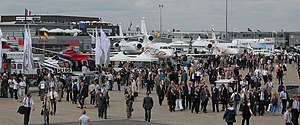
- Image via Wikipedia
Boeing is expected to conduct the maiden flight of the 787 Dreamliner this month. The plane has been plagued by delays. When the A380 was plagued by wiring problems, we said that Boeing had to make sure that it got the Dreamliner out on time to ensure the lead it got was maintained. Long story short…it didn’t. It isn’t surprising that the plane is late, however. It is the most technologically advanced aircraft ever built, incorporating a variety of new technologies that have produced significant birthing pains.
The test flight, overdue as it is, will begin the flight certification process for the plane, which is set to be delivered to its launch customer, All Nippon Airways(ANA) in March of 2010, almost two years late. Boeing has had to provide concessions to its airline customers because it has missed promised deadlines. Boeing is trying, as a result, to expedite the testing process from 12 to 8-9 months to meet deadlines.
When Boeing launched the 777 in 1994, the 11-month testing phase included nine planes that flew a combined 70 to 80 flight hours a month. The 787 testing phase could be three months shorter, and the six planes are expected to fly about 120 hours a month.
This year, Boeing has taken orders for 73 new planes, but 66 have been canceled, for a net gain of only seven. Last year, Boeing recorded net orders of 662 aircraft. Boeing says it still has orders for about 865 Dreamliners from 56 airlines and is prepared to boost production in the coming months. In order to do so, it will have to accelerate production once the plane is approved, which will involve rectifying manufacturing problems with its various subcontractors. The 787 is the most subcontracted Boeing aircraft in the company’s history, with contractors as far away as Italy and Japan.
Reports indicate that Boeing’s popular 777 will be improved or replaced, with a decision made within the next two years. Eventually, there will be an all-composite replacement for the aircraft, the design feature most noticeable on the 787. An all-composite version of the aircraft would be 20-25% lighter and significantly reduce fuel burn. They are also considering as an alternative, rewinging the existing aircraft.
Boeing needs to make its plans quickly, as Airbus plans to introduce its A350 series, which will compete with the 777 in size, by 2013.
Meanwhile, at the Paris Air Show, when airlines are known to announce orders, Airbus did better than expected. Airbus received orders from Vietnam Airlines, Cebu Pacific of the Philippines, and AirAsia X of Malaysia, as well as an order for 50 A320s from Hungarian carrier Wizz Air.
While that covers wide-bodied aircraft, what about single-aisle aircraft? Boeing is looking at the possible future for the long-successful 737 and Airbus for the A320. The A30X, the possible Airbus successor, may not come to market till 2020 or 2022.
What report would be complete without discussing the Sukhoi Superjet? Sukhoi, long since left in the dust, is launching a comeback to the market with the Superjet 100, a 100-seat regional plane. It expects to sell seventy percent of the planes outside of Russia. There are 122 firm orders from the plane, but most of them are Russian. Sukhoi is the first to market of several manufacturers entering the regional jet market, including Mitsubishi and Chinese company AVIC. They will compete with established regional jet manufacturers Embraer and Bombardier.
The Sukhoi is very different from the regional jets we are used to. The plane will have a three and two configuration, like an MD-80, but will be three inches wider, and three inches more headroom in the aisle. We predict the increased interior room will make this aircraft popular. Hopefully the competitors can work on increasing their regional jet interiors as well.
![Reblog this post [with Zemanta]](http://img.zemanta.com/reblog_e.png?x-id=e30fb184-8a8a-49b0-9190-b812f5711eeb)